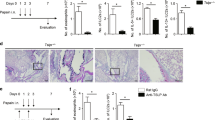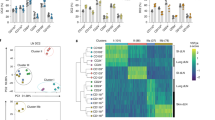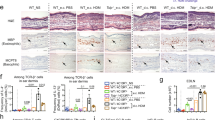Abstract
Whether epithelial cells play a role in triggering the immune cascade leading to T helper 2 (TH2)-type allergic inflammation is not known. We show here that human thymic stromal lymphopoietin (TSLP) potently activated CD11c+ dendritic cells (DCs) and induced production of the TH2-attracting chemokines TARC (thymus and activation-regulated chemokine; also known as CCL17) and MDC (macrophage-derived chemokine; CCL22). TSLP-activated DCs primed naïve TH cells to produce the proallergic cytokines interleukin 4 (IL-4), IL-5, IL-13 and tumor necrosis factor-α, while down-regulating IL-10 and interferon-γ. TSLP was highly expressed by epithelial cells, especially keratinocytes from patients with atopic dermatitis. TSLP expression was associated with Langerhans cell migration and activation in situ. These findings shed new light on the function of human TSLP and the role played by epithelial cells and DCs in initiating allergic inflammation.
This is a preview of subscription content, access via your institution
Access options
Subscribe to this journal
Receive 12 print issues and online access
$209.00 per year
only $17.42 per issue
Buy this article
- Purchase on Springer Link
- Instant access to full article PDF
Prices may be subject to local taxes which are calculated during checkout









Similar content being viewed by others
References
Kay, A.B. Allergy and allergic diseases. First of two parts. N. Engl. J. Med. 344, 30–37 (2001).
Mosmann, T.R. & Coffman, R.L. TH1 and TH2 cells: different patterns of lymphokine secretion lead to different functional properties. Annu. Rev. Immunol. 7, 145–173 (1989).
Abbas, A.K., Murphy, K.M. & Sher, A. Functional diversity of helper T lymphocytes. Nature 383, 787–793 (1996).
Constant, S.L. & Bottomly, K. Induction of TH1 and TH2 CD4+ T cell responses: the alternative approaches. Annu. Rev. Immunol. 15, 297–322 (1997).
Renauld, J.C. New insights into the role of cytokines in asthma. J. Clin. Pathol. 54, 577–589 (2001).
Holgate, S.T. Science, medicine, and the future. Allergic disorders. Brit. Med. J. 320, 231–234 (2000).
Busse, W.W. & Lemanske, R.F. Jr. Asthma. N. Engl. J. Med. 344, 350–362 (2001).
Banchereau, J. & Steinman, R.M. Dendritic cells and the control of immunity. Nature 392, 245–252 (1998).
Holt, P.G. Macrophage: dendritic cell interaction in regulation of the IgE response in asthma. Clin. Exp. Allergy 23, 4–6 (1993).
Lambrecht, B.N. et al. Myeloid dendritic cells induce TH2 responses to inhaled antigen, leading to eosinophilic airway inflammation. J. Clin. Invest. 106, 551–559 (2000).
Semper, A.E., Gudin, A.M., Holloway, J.A. & Holgate, S.T. in Dendritic Cells (eds. Lotze, M. T. & Thomson, A. W.) 435–456 (Academic Press, San Diego, CA,1999).
Stingl, G. in Immunological and Pharmacological Aspects of Atopic and Contact Eczema (ed. Czernielewski, J .M.) 1–9 (Karger, Basel, 1991).
Sims, J.E. et al. Molecular cloning and biological characterization of a novel murine lymphoid growth factor. J. Exp. Med. 192, 671–680 (2000).
Tonozuka, Y. et al. Molecular cloning of a human novel type I cytokine receptor related to δ/TSLPR. Cytogenet. Cell Genet. 93, 23–25 (2001).
Pandey, A. et al. Cloning of a receptor subunit required for signaling by thymic stromal lymphopoietin. Nature Immunol. 1, 59–64 (2000).
Park, L.S. et al. Cloning of the murine thymic stromal lymphopoietin (TSLP) receptor: Formation of a functional heteromeric complex requires interleukin 7 receptor. J. Exp. Med. 192, 659–670 (2000).
Reche, P.A. et al. Human thymic stromal lymphopoietin preferentially stimulates myeloid cells. J. Immunol. 167, 336–343 (2001).
Ray, R.J., Furlonger, C., Williams, D.E. & Paige, C.J. Characterization of thymic stromal–derived lymphopoietin (TSLP) in murine B cell development in vitro. Eur. J. Immunol. 26, 10–16 (1996).
Levin, S.D. et al. Thymic stromal lymphopoietin: a cytokine that promotes the development of IgM+ B cells in vitro and signals via a novel mechanism. J. Immunol. 162, 677–683 (1999).
Koch, F. et al. High level IL-12 production by murine dendritic cells: upregulation via MHC class II and CD40 molecules and downregulation by IL-4 and IL-10. J. Exp. Med. 184, 741–746 (1996).
Cella, M. et al. Ligation of CD40 on dendritic cells triggers production of high levels of interleukin-12 and enhances T cell stimulatory capacity: T-T help via APC activation. J. Exp. Med. 184, 747–752 (1996).
Pulendran, B. et al. Distinct dendritic cell subsets differentially regulate the class of immune response in vivo. Proc. Natl. Acad. Sci. USA 96, 1036–1041 (1999).
Maldonado-Lopez, R. et al. CD8α+ and CD8α− subclasses of dendritic cells direct the development of distinct T helper cells in vivo. J. Exp. Med. 189, 587–592 (1999).
Rissoan, M.C. et al. Reciprocal control of T helper cell and dendritic cell differentiation. Science 283, 1183–1186 (1999).
Homey, B. & Zlotnik, A. Chemokines in allergy. Curr. Opin. Immunol. 11, 626–634 (1999).
Moore, K.W., de Waal Malefyt, R., Coffman, R. L. & O'Garra, A. Interleukin-10 and the interleukin-10 receptor. Annu. Rev. Immunol. 19, 683–765 (2001).
O'Garra, A. Cytokines induce the development of functionally heterogeneous T helper cell subsets. Immunity 8, 275–283 (1998).
Vestergaard, C. et al. A TH2 chemokine, TARC, produced by keratinocytes may recruit CLA+CCR4+ lymphocytes into lesional atopic dermatitis skin. J. Invest. Dermatol. 115, 640–646 (2000).
Imai, T. et al. Selective recruitment of CCR4-bearing TH2 cells toward antigen-presenting cells by the CC chemokines thymus and activation-regulated chemokine and macrophage-derived chemokine. Int. Immunol. 11, 81–88 (1999).
Andrew, D.P. et al. C-C chemokine receptor 4 expression defines a major subset of circulating nonintestinal memory T cells of both TH1 and TH2 potential. J. Immunol. 166, 103–111 (2001).
de Saint-Vis, B. et al. A novel lysosome-associated membrane glycoprotein, DC-LAMP, induced upon DC maturation, is transiently expressed in MHC class II compartment. Immunity 9, 325–336 (1998).
Hammad, H. et al. TH2 polarization by Derp 1–pulsed monocyte-derived dendritic cells is due to the allergic status of the donors. Blood 98, 1135–1141 (2001).
McWilliam, A.S. et al. Dendritic cells are recruited into the airway epithelium during the inflammatory response to a broad spectrum of stimuli. J. Exp. Med. 184, 2429–2432 (1996).
Novak, N., Haberstok, J., Geiger, E. & Bieber, T. Dendritic cells in allergy. Allergy 54, 792–803 (1999).
Tunon-De-Lara, J.M. et al. Dendritic cells in normal and asthmatic airways: expression of the α subunit of the high affinity immunoglobulin E receptor (Fcε RI-α). Clin. Exp. Allergy 26, 648–655 (1996).
Holt, P.G., Macaubas, C., Cooper, D., Nelson, D.J. & McWilliam, A.S. Th-1/Th-2 switch regulation in immune responses to inhaled antigens. Role of dendritic cells in the aetiology of allergic respiratory disease. Adv. Exp. Med. Biol. 417, 301–306 (1997).
Homey B. et al. CCL27-CCR10 interactions regulate T cell-mediated skin inflammation. Nature Med. 8, 157–65 (2002).
Romagnani S. T-cell responses in allergy and asthma. Curr. Opin. Allergy. Clin. Immunol. 1, 73–78 (2002).
Robinson, D.S. et al. Increased interleukin-10 messenger RNA expression in atopic allergy and asthma. Am. J. Respir. Cell. Mol. Biol. 14, 113–117 (1996).
Borish, L. et al. Interleukin-10 regulation in normal subjects and patients with asthma. J. Allergy. Clin. Immunol. 97, 1288–1296 (1996).
Akbari, O., DeKruyff, R.H. & Umetsu, D.T. Pulmonary dendritic cells producing IL-10 mediate tolerance induced by respiratory exposure to antigen. Nature Immunol. 2, 725–731 (2001).
Zuany-Amorim, C. et al. Interleukin-10 inhibits antigen-induced cellular recruitment into the airways of sensitized mice. J. Clin. Invest. 95, 2644–2651 (1995).
Siegal, F.P. et al. The nature of the principal type 1 interferon-producing cells in human blood. Science 284, 1835–1837 (1999).
Acknowledgements
We thank L. Lanier, J.-Z. Chen and J. Banchereau for critical reading of the manuscript and M. Andonian for help with graphics. DNAX Research Institute is supported by Schering-Plough.
Author information
Authors and Affiliations
Corresponding author
Ethics declarations
Competing interests
DNAX Research Inc is a wholly owned subsidiary of the Schering Corporation, Kenilworth, NJ.
Rights and permissions
About this article
Cite this article
Soumelis, V., Reche, P., Kanzler, H. et al. Human epithelial cells trigger dendritic cell–mediated allergic inflammation by producing TSLP. Nat Immunol 3, 673–680 (2002). https://doi.org/10.1038/ni805
Received:
Accepted:
Published:
Issue Date:
DOI: https://doi.org/10.1038/ni805
This article is cited by
-
Evodiae Fructus extract suppresses inflammatory response in HaCaT cells and improves house dust mite-induced atopic dermatitis in NC/Nga mice
Scientific Reports (2024)
-
The role of thymic stromal lymphopoietin in cutaneous disorders
Archives of Dermatological Research (2024)
-
Paedoksan ameliorates allergic disease through inhibition of the phosphorylation of STAT6 in DNCB-induced atopic dermatitis like mice
Applied Biological Chemistry (2023)
-
The translational revolution in atopic dermatitis: the paradigm shift from pathogenesis to treatment
Cellular & Molecular Immunology (2023)
-
Role of thymic stromal lymphopoietin in allergy and beyond
Nature Reviews Immunology (2023)



